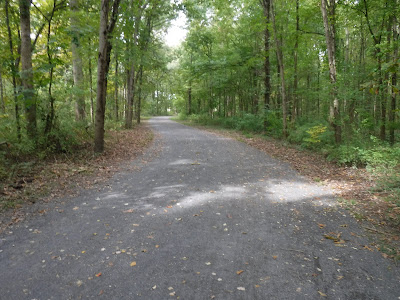Almost two weeks ago, we pedaled the 10 mile northern segment of the Perkiomen Trail. Today was the day to put our wheels on the 10-mile southern end of the trail.
Our total mileage today was almost 22 miles as we included part of the Audubon Loop Trail at the southern end. Fall was clearly showing on the trail:
The Audubon Loop Trail encircles the John James Audubon Center at Mill Grove, which we plan to visit in the near future, so we won't spend much time discussing that facility, except to say that the ground are impressive. Mill Grove was the location where Audubon first developed his famous method of depicting birds and other wildlife.
The Audubon Loop Trail passes some other interesting sites, including Martha's Community Farm, recently launched by Martha’s Choice Marketplace, a ministry of Catholic Social Services of the Archdiocese of Philadelphia. The farm, located on the grounds of the former Saint Gabriel’s Hall in Audubon, Pennsylvania, grows produce, flowers, and herbs to benefit individuals and households served by Martha’s Choice Marketplace. Items grown also support Martha’s Choice Marketplace’s network of food pantries throughout Montgomery County.
Directly across the street is the old Saint Gabriel's Hall, operated by the De La Salle Christian Brothers, which has closed. It housed a residential and educational program for Philadelphia youths ages 13 to 19 whose situations were determined by the courts; the Mitchell Program, a 120-day residential treatment program; and De La Salle Vocational (DelVoc), a treatment center and educational program based in Bensalem.
After passing the Audubon Center itself, we came up alongside the smokestack of the powerhouse that operated the copper mine operation at Mill Grove:
After something over a mile, we reached the Perkiomen Trail itself, here in the community of Oaks, Pennsylvania. At the first bridge, we had a beautiful view of Perkiomen Creek -- one of many along the trail, which runs beside the creek:
A variety of bird life inhabits the waterway, including herons --
-- geese, egrets, hawks, and, we're sure, many other species we didn't spot. At a number of spots, the termini of old roads have been redeveloped as fishing docks for the locals:
Some property owners along Perkiomen Creek are lucky enough to have small docks where they can store paddle craft. On our peddle, we spotted a number of fishermen casting from kayaks to undercut banks that would otherwise be unreachable.
The Perkiomen Creek suffered a major flood in early September 2021, with waters reaching an unprecedented height of over 26 feet. Along one section of the creek, where the western bank was walled by a dark stone cliff, properties on the eastern bank were inundated when the waters had nowhere to flow. This property still shows the sad, empty foundation and deck of a house that was wiped away by the flood:
The flood prompted a wide variety of reclamation projects, including regrading banks, riprap of banks and other augmentation with stone and concrete, as well as safety fences along the trail to protect users from unsafe cliffs:
Further along, we were surprised to run across a number of fallen breadfruit, which is the fruit of a species of flowering tree in the mulberry and jackfruit family. It is believed to have originated in New Guinea, the Maluku Islands, and the Philippines. It was spread to other tropical regions of the world during the Colonial Era and apparently has also now been propogated in Pennsylvania.
Another marvel of nature was to appear to us not a lot further on, when we rode by a Swamp White Oak, over 80 feet tall, which is said to have been alive since 1694, making it 328 years old! Below, Kathy inspects the tree and reviews the information about it on a trailside marker:
This trail just kept on giving to us. Again, it wasn't long after leaving Collegeville that we came across a miniature steam train exhibit by the Pennsylvania Live Steamers, a volunteer group established in 1946 and dedicated to the preservation of the nation’s rich mechanical and engineering heritage. The group's purpose is to formulate and carry out plans for the construction and operation of a live steam railroad and to foster a spirit of cooperation among live steam railroaders. The 5-acre club site has 3,200 feet of 1½″ scale (7¼″ gauge) track, 3,000 feet of 1″ scale (4¾″ gauge) track, an 800-foot multi-gauge track loop and a 219-foot dual-tracked Gauge-1 loop. There are multiple unloading facilities.
The trail weaves back and forth across Perkiomen Creek, with a variety of architecture visible along its banks:
One trail bridge is an old railroad bridge which has been stabilized and repurposed for mutli-use recreation:
A number of small creeks empty into the Perkiomen, including this picturesque Schoolhouse Run:
We were nearing our turnaround point at 11 miles, and we were both getting hungry. As we reached a wetland with numerous cattails, Kathy may have mistaken this punk-on-a-stick for a corn dog in her famished state:
Luckily, she came to her senses. In another mile or so, we reached a trailhead and were able to wolf down lunch and some dessert of pears and apples. After a rest and rehydration, we were ready to peddle back south to our point of beginning. Luckily, the trail was mostly downhill on the way back, so our return ride was easier than the ride upstream.
We're tired and our legs are a little sore, but this has whetted our appetite for more rails-to-trails adventures -- of which there are many in Southeastern Pennsylvania. We have to sit down and map out some more of these trips!
Stay active, my friends.



















































